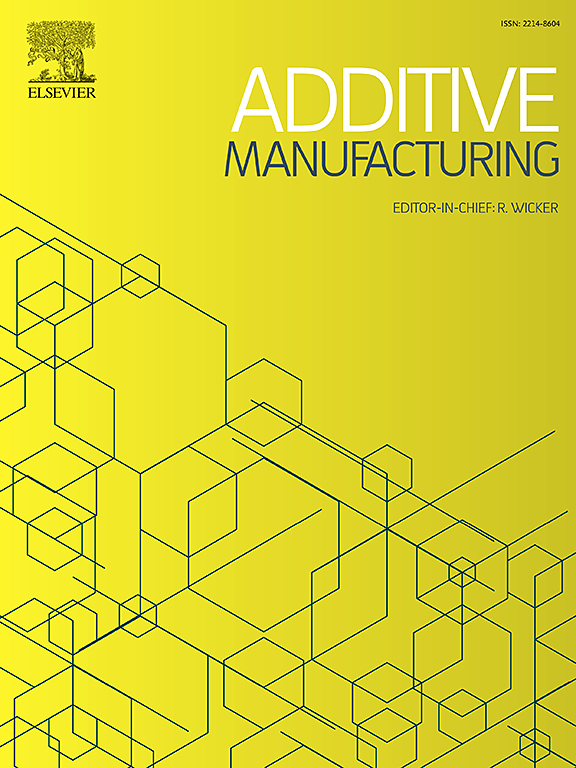Influence of remelting sequence on defect generation and high-temperature mechanical properties in laser powder bed fusion of IN718 alloys
IF 10.3
1区 工程技术
Q1 ENGINEERING, MANUFACTURING
引用次数: 0
Abstract
The laser multiple melting strategy is commonly employed in the laser powder bed fusion (LPBF) process to reduce porosity levels and optimize mechanical properties. However, the influence of the temporal sequences of energy input has received limited attention, despite their potential to control defect generation and microstructure evolution. Therefore, in this work, two specific remelting sequences were investigated, referred to here as the preheating strategy (a low-energy first scan followed by a high-energy second scan) and the remelting (a high-energy first scan followed by a low-energy second scan) strategy. The findings indicated that defect generation and surface roughness are highly sensitive to variations in the remelting sequences, demonstrating that samples subjected to the remelting strategy exhibit significantly lower porosity levels. The simulations revealed that the defects in the preheating strategy originate from insufficient melting between layers and rough top surfaces caused by inadequate melt pool flow. Additionally, the samples subjected to the remelting strategy exhibited superior high-temperature mechanical properties, with an ultimate tensile strength of 959.7 MPa, yield strength of 792.0 MPa, and outstanding elongation of 23.1 % along the building direction after heat treatment. This enhancement was attributed to the increased geometrically necessary dislocation density induced by fine carbides measuring 0.9 μm. This study offers valuable insights into the laser multiple melting process, providing a foundation for future research aimed at optimizing mechanical properties in the LPBF process.
重熔顺序对IN718合金激光粉末床熔焊缺陷产生及高温力学性能的影响
在激光粉末床熔合(LPBF)工艺中,为了降低孔隙率和优化力学性能,通常采用激光多次熔化策略。然而,能量输入时间序列的影响受到的关注有限,尽管它们有可能控制缺陷的产生和微观结构的演变。因此,在这项工作中,研究了两种特定的重熔顺序,即预热策略(低能第一次扫描后进行高能第二次扫描)和重熔策略(高能第一次扫描后进行低能第二次扫描)。结果表明,缺陷的产生和表面粗糙度对重熔顺序的变化高度敏感,表明经过重熔策略的样品具有明显较低的孔隙率。模拟结果表明,预热策略的缺陷主要是由于层间熔化不足和熔池流动不足造成的顶面粗糙。此外,经过重熔处理的试样具有优异的高温力学性能,热处理后的抗拉强度为959.7 MPa,屈服强度为792.0 MPa,沿组织方向的伸长率为23.1 %。这种增强是由于尺寸为0.9 μm的细碳化物引起的几何必需位错密度增加。该研究为激光多重熔融工艺提供了有价值的见解,为进一步优化LPBF工艺的力学性能奠定了基础。
本文章由计算机程序翻译,如有差异,请以英文原文为准。
求助全文
约1分钟内获得全文
求助全文
来源期刊

Additive manufacturing
Materials Science-General Materials Science
CiteScore
19.80
自引率
12.70%
发文量
648
审稿时长
35 days
期刊介绍:
Additive Manufacturing stands as a peer-reviewed journal dedicated to delivering high-quality research papers and reviews in the field of additive manufacturing, serving both academia and industry leaders. The journal's objective is to recognize the innovative essence of additive manufacturing and its diverse applications, providing a comprehensive overview of current developments and future prospects.
The transformative potential of additive manufacturing technologies in product design and manufacturing is poised to disrupt traditional approaches. In response to this paradigm shift, a distinctive and comprehensive publication outlet was essential. Additive Manufacturing fulfills this need, offering a platform for engineers, materials scientists, and practitioners across academia and various industries to document and share innovations in these evolving technologies.
 求助内容:
求助内容: 应助结果提醒方式:
应助结果提醒方式:


